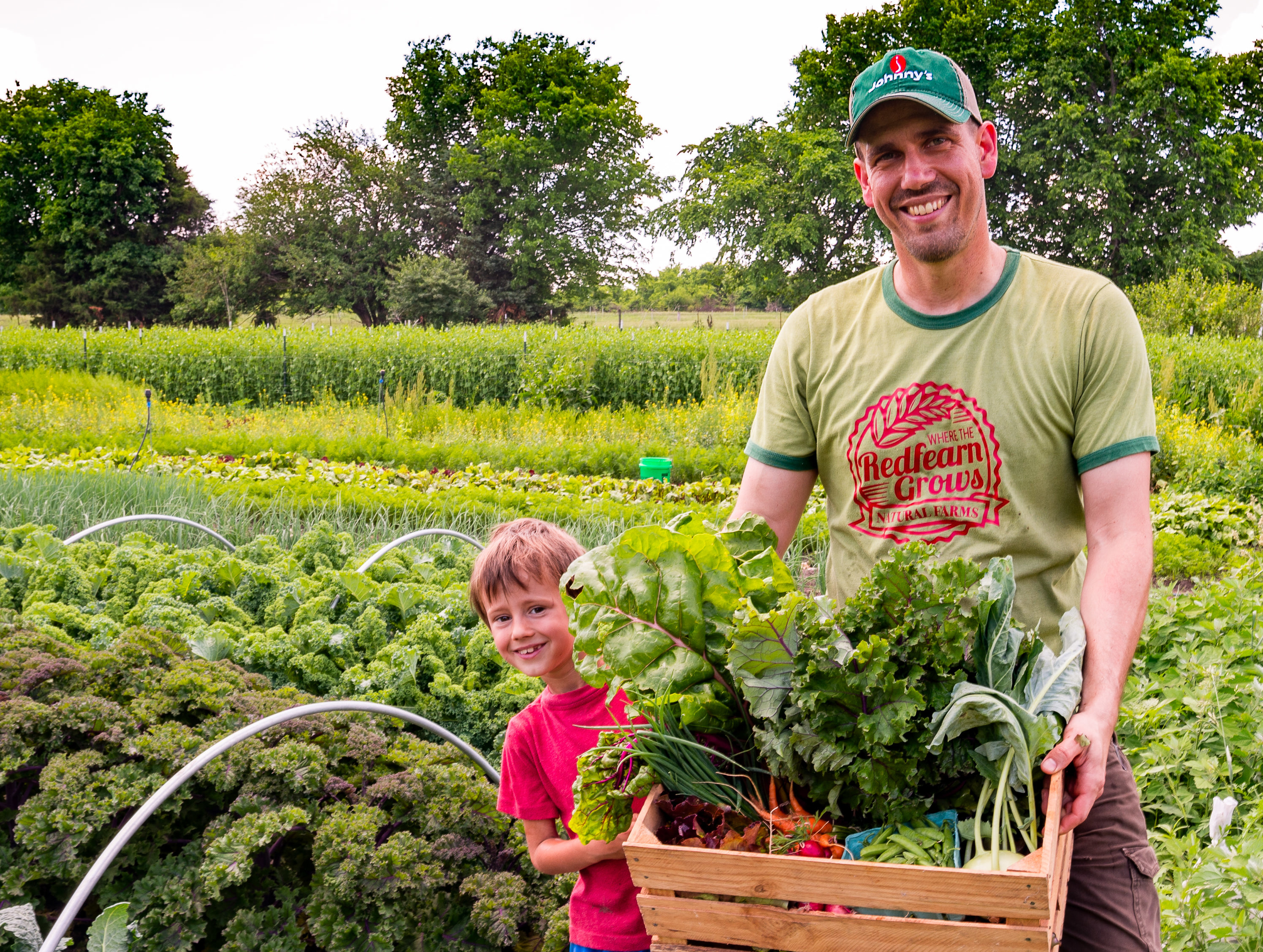If you haven’t signed up for the CSA, you still can!
For the 1st week of the CSA main season, members with Basic shares will be able to choose 5 items each week and members with Premium will be able to choose 8 items each week. The produce available for the Week 1 are: Sugar Snap Peas, Spring Salad Mix, Carrot bunches with tops, Zucchini/ Yellow Squash, Curly Kale, Swiss Chard, Beet bunches and Snacker Cucumbers and “Half” items: English Cucumber, Basil, Cilantro, Radishes, Kohlrabi bulb and Green Onion bunches.
Sugar Snap Peas (Whole Item): Store in plastic bag in the refrigerator. Peel off the strings on the sugar snap peas before eating or cooking. Sugar snap peas are great raw or barely cooked. Try Stir-fried Sugar Snap Peas or Sugar Snap Peas with orange-ginger dressing.
Salad mix (Whole Item): Store in plastic bag in the refrigerator. For salad inspiration, look at this: Mesclun Salad with goat cheese, or Chart of Salad Toppings Combinations.
Carrots (Choice Item): Storage suggestion: Separate the tops from the roots, and store separately in the fridge. The tops can be stored in a plastic bag. Place carrots in a containers with lid and cover completely in water. Keep container in the refrigerator, changing the water ever 4-5 days. Carrot top soup is a great way to use the tops (and this recipe uses some carrots also). In addition to just eating raw carrot sticks, carrots can also be roasted, as in this wonderful Roasted Cumin-Lime Carrots recipe.
Kale (Choice Item): store in plastic bag in refrigerator. Serving suggestions: Add to smoothies, Fall Kale salad , Cookie+ Kate’s Kale Salad with an amazing dressing, Zuppa Tuscana soup (I usually add a can of tomatoes to this soup and sometimes kidney beans), Kale Pesto (this recipe is served with pasta and roasted butternut squash) and Kale and Butternut squash frittata. To preserve: wash kale, cut off the stems, blanch in boiling water for 30 seconds, then cool in an ice bath, drain well and freeze. Frozen kale can be used in soups, added to casseroles, pasta dishes, or anything that uses cooked kale.
Summer squash: patty pan and zucchini (Choice Item, 3 squash or a box will count as one item): store in plastic bag in refrigerator. Yellow squash nearly interchangeable with zucchini and is great raw or sautéed, grilled, or baked into zucchini bread (my kids favorite way to eat zucchini!). Raw zucchini/ squash makes a fresh, flavorful salad as in this: Summer Squash Salad with Lemon Citronette. Zucchini (sliced and broiled or pan fried) can take the place of pasta in lasagna. If you want more ideas, you can try Baked Zucchini Fries, Zucchini Fritters or Chocolate Zucchini Bread or these main dishes Baked Penne with Roasted Vegetables (this is a great recipe to use a lot of vegetables, including zucchini, yellow squash, eggplant, peppers, onions and garlic), Cheesy Zucchini Casserole (which we make with shredded sharp cheddar, instead of Velvetta). Here’s a couple other zucchini recipes, recommended by CSA members: Curried Zucchini Soup, Zucchini Tots, Sauteed Zucchini with Cherry Tomatoes (don’t overcook the zucchini!), and Zucchini Chocolate Rum Cake. To preserve: Zucchini or Yellow squash can be shredded and frozen to use in Zucchini bread recipes.
Cucumbers : store in plastic bag in refrigerator (our cucumbers are not waxed, so will lose moisture and become rubbery if not wrapped). Recipe Ideas: Cucumber infused Water, Smoothies with Cucumbers, Cucumber Salads: Creamy Cucumber Salad with Greek Yogurt and Dill, Cucumber Salad with Garlic and Ginger and even Stir-fried Cucumbers! Pair with tomatoes in an Israeli Salad, Cucumber, Tomato, and Avocado Salad, Greek Salad and Panzanella Salad. Cucumbers are the base for the Mediterranean sauce, Tzatziki. Cold Cucumber Soup is also a refreshing way to use cucumbers.
Radishes (HALF Item): Store in plastic bag in refrigerator. Crisp radishes in ice water. Sliced radishes add great flavor to salads. You can also just eat them straight with butter and a sprinkle of salt. There are many variations of radish salads, here are a couple: Radish and Mint Salad , Smitten Kitchen’s chopped salad, and Radish, Cucumber and Orange Salad. Radishes are milder when roasted or cooked. I cut radishes in half and toss with a little olive oil, salt and pepper and roast at 425F until tender crisp (they can be roasted alongside sweet potatoes or carrots for a nice flavor and color combination).
Green Onions (HALF Item): Store in plastic bag in the refrigerator. Use in lots of Chinese/ other asian recipes (General Tso’s chicken and Korean beef are two Redfearn favorites) chicken salad, egg salad, salad dressing to name a few.
Cilantro (HALF Item): Wrap cilantro in a damp paper towel and then put it in a plastic bag in refrigerator. Alternatively, place in a jar of water (like cut flowers) loosely covered with a plastic bag in the refrigerator.
Kohlrabi (HALF Item): Both the leaves and the bulbous stem (the round part) are edible. The bulbous part can last for a couple weeks in the fridge, but the greens should be use within a couple days, both should be stored in plastic bags in the refrigerator . The bulb should be peeled by cutting off a thin slice on the top and bottom of the bulb and using a paring knife to cut the skin off the kohlrabi bulb.Here is a link with recipes using the kohlrabi bulb and greens, including one of our favorites, the kohlrabi patties: Kohlrabi Recipes. A simple preparation of kohlrabi is Butter- braised Kohlrabi: Peel kohlrabi, and thinly slice (1/8 to 1/4 inch thick) and cook in a skillet with butter and olive oil and salt and pepper, add about 1/2 cup of chicken broth, cover the skillet and cook, stirring occasionally, until tender. Optional: Cream can be added at the end. Eaten raw, kohlrabi is fresh, crisp, and the ideal ingredient for a summer slaw, such as this Kohlrabi and Carrot slaw or in this excellent Kohlrabi- Apple Salad!
Garlic Scapes (HALF Item): Store in plastic bag in the refrigerator. Garlic Scapes are the flower bud of the garlic plant. The bud is removed to encourage the bulbs to thicken up. Scapes taste just like garlic. They can be used the same way as garlic in nearly any recipe. On thicker scapes, snap off the woody end (in the same way you would snap asparagus). Try them in a sauté, roasted, pickled, added to soups, and more. The most tender tops of the stem and the buds are delicious chopped up raw. To preserve: Chop the scapes in a food processor, add to jars and cover with olive oil. Save this in the fridge for up to a year, sometimes add more oil to keep it covered. Use on salads, baste on meats and vegetables for grilling, garlic bread, anything your imagination can think of. You can also freeze cubes of this in a ice cube tray then put in a zip lock bag and keep frozen.
A site highlighting many ways to serve garlic scapes; including a garlic scape pesto recipe: What to do with Garlic Scapes (Note: my family made the Garlic Scape Pesto from this link, using sunflower seeds instead of pine nuts, and it was wonderful (and very garlicky!).
Garlic Scape and White Bean Hummus
1/3 cup sliced scapes
1 T lemon juice
1/2 tsp sea salt
ground black pepper
1 can (15 oz.) cannelloni beans, rinsed and drained
1/4 cup olive oil
In a food processor, process scapes with lemon juice, salt and pepper until finely chopped. Add beans and process to a rough puree. With motor running, slowly drizzle olive oil through feed tube and process until fairly smooth. Pulse in 2 or 3 T water, or more, until mixture is the consistency of a dip.
If you would like more recipe ideas, I have a pinterest board devoted to CSA vegetable recipes: http://www.pinterest.com/sheriredfearn/csa-veggies-recipes/

